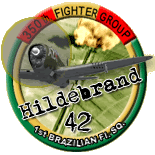Teste "São Tomé":

mp-dotrange ajustado para mostrar dot a 20km bem como a maledeta etiqueta com a distância.
A etiqueta começa a ficar visível a ~15KM.
O dot (a resolução do monitor influência - quanto maior pior - mas não muito) mas em geral a 10/12KM.
E esse "verniz"
"Oh, mas um estudo da US Navy nos anos 70/80 diz que em condições ideais o piloto de F-14 consegue detectar aviões a uns 30* KM!!!" (Tem muros de texto a respeito no Banana's).
Bem, parece que o Oleg andou lendo o livro "The Most Dangerous Enemy"(1) do Sthepan Bungay sobre a BoB (ou talvez o Sthepan andou jogando os sim do Oleg
Detection is the first and most important. In World War I this depended on seeing the enemy.
In World War II it still depended largely on sight, but it helped to have a controller telling you over the radio roughly where your enemy was.
The sky had to be systematically quartered and searched.
In perfect conditions, a single aircraft can be picked up at a range of about two miles; in haze it is less.
A large formation can be seen from far further away, perhaps four miles.
An aircraft approaching head-on is harder to acquire visually because itis smaller and offers no relative movement.
In the air above the clouds, the sun is bright and effectively blocks out about 15% of the field of vision.
Flying upsun makes an aircraft virtually invisible.
*Chutado, não lembro...
(1) Livro danado de bom, da até dó dos alemães, entraram numa batalha perdida antes de começar, a premissa era conseguir um k/d de 5:1 que acabou se tornando 2/3:1 contra eles, e com "rules of engajament" tipo Vietnam, a princípio "não pode bombardear alvo no continente, não pode bombardear Londres"...ai com o (bom) tempo acabando tentaram um vale tudo estratégico sendo que nem o tático havia feito sucesso.
BTW - O "The most dangerous enemy" são os ingleses.
Sokol1





